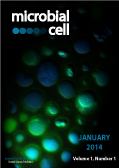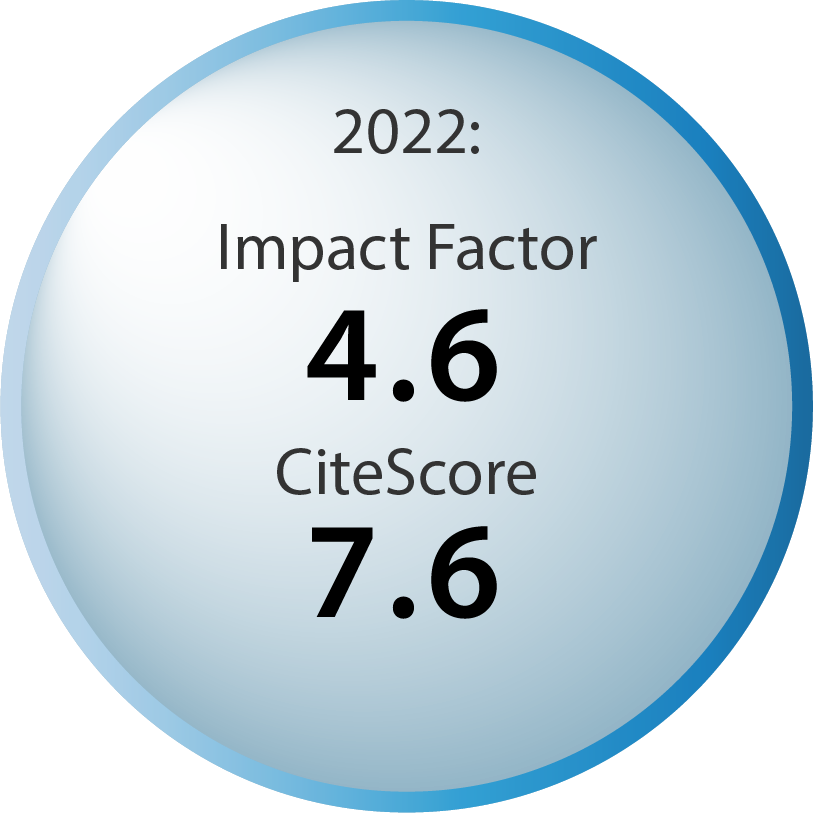What’s the role of autophagy in trypanosomes?
Katherine Figarella, Néstor L. Uzcátegui
News and thoughts |
page 6-8 | 10.15698/mic2014.01.126 | Full text | PDF |
Reduced TORC1 signaling abolishes mitochondrial dysfunctions and shortened chronological lifespan of Isc1p-deficient cells
Vitor Teixeira, Tânia C. Medeiros, Rita Vilaça, Pedro Moradas-Ferreira, and Vítor Costa.
Research Articles |
page 21-36 | 10.15698/mic2014.01.121 | Full text | PDF |
Abstract
The target of rapamycin (TOR) is an important signaling pathway on a hierarchical network of interacting pathways regulating central biological processes, such as cell growth, stress response and aging. Several lines of evidence suggest a functional link between TOR signaling and sphingolipid metabolism. Here, we report that the TORC1-Sch9p pathway is activated in cells lacking Isc1p, the yeast orthologue of mammalian neutral sphingomyelinase 2. The deletion of TOR1 or SCH9 abolishes the premature aging, oxidative stress sensitivity and mitochondrial dysfunctions displayed by isc1Δ cells and this is correlated with the suppression of the autophagic flux defect exhibited by the mutant strain. The protective effect of TOR1 deletion, as opposed to that of SCH9 deletion, is not associated with the attenuation of Hog1p hyperphosphorylation, which was previously implicated in isc1Δ phenotypes. Our data support a model in which Isc1p regulates mitochondrial function and chronological lifespan in yeast through the TORC1-Sch9p pathway although Isc1p and TORC1 also seem to act through independent pathways, as isc1Δtor1Δ phenotypes are intermediate to those displayed by isc1Δ and tor1Δ cells. We also provide evidence that TORC1 downstream effectors, the type 2A protein phosphatase Sit4p and the AGC protein kinase Sch9p, integrate nutrient and stress signals from TORC1 with ceramide signaling derived from Isc1p to regulate mitochondrial function and lifespan in yeast. Overall, our results show that TORC1-Sch9p axis is deregulated in Isc1p-deficient cells, contributing to mitochondrial dysfunction, enhanced oxidative stress sensitivity and premature aging of isc1Δ cells.
Tracking autophagy during proliferation and differentiation of Trypanosoma brucei
William R. Proto, Nathaniel G. Jones, Graham H. Coombs, and Jeremy C. Mottram
Research Articles |
page 9-20 | 10.15698/mic2014.01.120 | Full text | PDF |
Abstract
Autophagy is a lysosome-dependent degradation mechanism that sequesters target cargo into autophagosomal vesicles. The Trypanosoma brucei genome contains apparent orthologues of several autophagy-related proteins including an ATG8 family. These ubiquitin-like proteins are required for autophagosome membrane formation, but our studies show that ATG8.3 is atypical. To investigate the function of other ATG proteins, RNAi compatible T. brucei were modified to function as autophagy reporter lines by expressing only either YFP-ATG8.1 or YFP-ATG8.2. In the insect procyclic lifecycle stage, independent RNAi down-regulation of ATG3 or ATG7 generated autophagy-defective mutants and confirmed a pro-survival role for autophagy in the procyclic form nutrient starvation response. Similarly, RNAi depletion of ATG5 or ATG7 in the bloodstream form disrupted autophagy, but did not impede proliferation. Further characterisation showed bloodstream form autophagy mutants retain the capacity to undergo the complex cellular remodelling that occurs during differentiation to the procyclic form and are equally susceptible to dihydroxyacetone-induced cell death as wild type parasites, not supporting a role for autophagy in this cell death mechanism. The RNAi reporter system developed, which also identified TOR1 as a negative regulator controlling YFP-ATG8.2 but not YFP-ATG8.1 autophagosome formation, will enable further targeted analysis of the mechanisms and function of autophagy in the medically relevant bloodstream form of T. brucei.
Early manifestations of replicative aging in the yeast Saccharomyces cerevisiae.
Maksim I. Sorokin, Dmitry A. Knorre and Fedor F. Severin
Research Reports |
page 37-42 | 10.15698/mic2014.01.122 | Full text | PDF |
Abstract
The yeast Saccharomyces cerevisiae is successfully used as a model organism to find genes responsible for lifespan control of higher organisms. As functional decline of higher eukaryotes can start as early as one quarter of the average lifespan, we asked whether S. cerevisiae can be used to model this manifestation of aging. While the average replicative lifespan of S. cerevisiae mother cells ranges between 15 and 30 division cycles, we found that resistances to certain stresses start to decrease much earlier. Looking into the mechanism, we found that knockouts of genes responsible for mitochondria-to-nucleus (retrograde) signaling, RTG1 or RTG3, significantly decrease the resistance of cells that generated more than four daughters, but not of the younger ones. We also found that even young mother cells frequently contain mitochondria with heterogeneous transmembrane potential and that the percentage of such cells correlates with replicative age. Together, these facts suggest that retrograde signaling starts to malfunction in relatively young cells, leading to accumulation of heterogeneous mitochondria within one cell. The latter may further contribute to a decline in stress resistances.
A novel mechanism involved in the coupling of mitochondrial biogenesis to oxidative phosphorylation
Jelena Ostojić, Jean-Paul di Rago, Geneviève Dujardin
Microreviews |
page 43-44 | 10.15698/mic2014.01.123 | Full text | PDF |
Abstract
Mitochondria are essential organelles that are central to a multitude of cellular processes, including oxidative phosphorylation (OXPHOS), which produces most of the ATP in animal cells. Thus it is important to understand not only the mechanisms and biogenesis of this energy production machinery but also how it is regulated in both physiological and pathological contexts. A recent study by Ostojić et al. [Cell Metabolism (2013) 18, 567-577] has uncovered a regulatory loop by which the biogenesis of a major enzyme of the OXPHOS pathway, the respiratory complex III, is coupled to the energy producing activity of the mitochondria.
Identifying the assembly pathway of cyanophage inside the marine bacterium using electron cryo-tomography
Wei Dai, Michael F. Schmid, Jonathan A. King, Wah Chiu
Microreviews |
page 45-47 | 10.15698/mic2014.01.125 | Full text | PDF |
Abstract
Advances in electron cryo-tomography open up a new avenue to visualize the 3-D internal structure of a single bacterium before and after its infection by bacteriophages in its native environment, without using chemical fixatives, fluorescent dyes or negative stains. Such direct observation reveals the presence of assembly intermediates of the bacteriophage and thus allows us to map out the maturation pathway of the bacteriophage inside its host.
Stalling autophagy: a new function for Listeria phospholipases
Ivan Tattoli, Matthew T. Sorbara, Dana J. Philpott and Stephen E. Girardin.
Microreviews |
page 48-50 | 10.15698/mic2014.01.124 | Full text | PDF |
Abstract
Listeria monocytogenes is a Gram-positive bacterial pathogen that induces its own uptake in non-phagocytic cells. Following invasion, Listeria escapes from the entry vacuole through the secretion of a pore-forming toxin, listeriolysin O (LLO) that acts to damage and disrupt the vacuole membrane. Listeria then replicates in the cytosol and is able to spread from cell-to-cell using actin-based motility. In addition to LLO, Listeria produces two phospholipase toxins, a phosphatidylinositol-specific phospholipase C (PI-PLC, encoded by plcB) and a broad-range phospholipase C (PC-PLC, encoded by plcA), which contribute to bacterial virulence. It has long been recognized that secretion of PI- and PC-PLC enables the disruption of the double membrane vacuole during cell-to-cell spread, and those phospholipases have also been shown to augment LLO-dependent escape from the entry endosome. However, a specific role for Listeria phospholipases during the cytosolic stage of infection has not been previously reported. In a recent study, we demonstrated that Listeria PI-PLC and PC-PLC contribute to the bacterial escape from autophagy through a mechanism that involves direct inhibition of the autophagic flux in the infected cells [Tattoli et al. EMBO J (2013), 32, 3066-3078].










